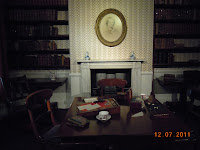 |
| Walking to Ripon Cathedral |
Today I’m blogging about the literary trail of my recent journey through England, that is, about all the places I visited linked to authors or literary works. My friends and I visited places someway connected to Lewis Carroll, The Brontes, Shakespeare, Jane Austen and the legendary Robin Hood.
 |
| The choir stall which is thought to have inspired Lewis Carroll |
1. 1. Ripon and Lewis Carrol - Our first day in Yorkshire was spent visiting York , as I told you before (HERE) but in the evening before going back to our lovely B&B in Easingwold, we made a stop in Ripon to visit the cathedral. Our guidebook funnily described it as a squat medieval building, and the idea of a squat cathedral made us laugh all the time all through the week. It was actually rather “squat” if observed from the outside and from the main entrance, but it looked beautiful and seemed to soar into the sky, as any Gothic cathedral does, from the inside. The literary connection is with Lewis Carroll, whose father was a Canon here from 1852 to 1868. In one of the choir stalls – completed in 1494 by Ripon woodcarvers - the carved figures represent a griffon chasing a rabbit whilst another rabbit hides down his hole. This is believed to have inspired Lewis Carroll while writing his Alice in Wonderland (1865)
2. Brontë Parsonage Museum - Howarth (West Yorkshire)
 |
| Howarth |
On 12th July we drove for miles and walked quite a bit to reach this remote village buried in the northern moorlands: Howarth. This was one of the goals I had chosen in my wish-list when planning this trip to England and my friends, though not really interested, accepted to add it to our schedule. Thanks a lot girls!
 |
| The dining room at the Parsonage |
I was really impressed by the bleak aspect of the place, in a windy greyish day. We all agreed that living there, any reasonable creature could but write sad and melancholic stories or even tragic. Jane Eyre, The Tenant of Wildfell Hall or Wuthering Heights could only be written in a place like that.
 |
| Howarth Church - Emily and Charlotte are buried here |
The Brontës came to Howarth in 1820 when Patrick Brontë was appointed Perpetual curate of Haworth Church. Within a few years Mrs Brontë and the two eldest daughters, Maria and Elizabeth, had died. For the remaining children, their parsonage home and its Yorkshire moorland setting were a profound influence, forming their characters and inspiring some of the most famous books ever written. The parsonage remained their home for the rest of their lives. Their unforgettable novels were written there, in the dining room, in the evenings when the rest of the household had retired for the night. In the tour of the parsonage you can visit Mr Brontë’s study, the dining room, the kitchen, Mr Arthur Bell Nicholl’s study, the servant’s room, Charlotte’s room, the children’s study (later Emily’s room), Mr Brontë’s bedroom, Branwell’s studio. After watching the detailed fictional account of the Brontës’ lives in that parsonage in The Brontës of Howarth, I had the impression of having been there already. And I felt sad and melancholic all the time. That house had witnessed lots of pain and sorrow, then solitude and isolation, with one only escape possible: into fantasy literary worlds.
 |
| Driving through Thornton |
Before leaving the village I wanted to buy something special as souvevnirs from the place, so I took a guidebook about the Parsonage Museum, Elizabeth Gaskell's biography of Charlotte Brontë, which I didn't have, as well as a very nice bookmark. Before heading to Sheffield and then Nottingham, we had a true but quick English lunch - cornish pastry and apple pie - and had a look at the ancient railways station. On our way south, we drove through Thornton, the village nearby, where Charlotte, Emily and Anne Brontë were born.
We spent the night in Nottingham where I decided to stay in our hotel room, feeling rather sick, instead of wandering about with my friends in search for somewhere nice to have dinner at. I turned on the TV and found an adaptation of Sarah Waters's The Night Watch on BBC2. I didn't like it that much - but maybe it was because I was unwell - despite the stellar cast's good performances: Anna Maxwell Martin (North and South, Bleak House, South Riding), Claire Foy (Little Dorrit), Jodie Whittaker (Accused), J.J. Feild (Northanger Abbey, Captain America) Harry Treadaway (Fish Tank) were there all together but I simply couldn't appreciate the story. Too quick, too confused. OK! Sorry for the digression, back to our literary trail. Back to Nottingham!
It is a modern city , perfect to go shopping. Very little reminds the visitor of the places or the atmospheres of the ballads of Robin Hood and his Merry Men - among shops and Jamie Oliver restaurants - except for The Robin Hood Trail Panels in the city centre. You don't expect to meet the wicked Sheriff or Guy of Gisborne wandering about and, honestly, the visit to the Castle was rather disappointing. The right place where you can really feel what the lives of the outlaws could be like or where you can have glimpses of Robin and Guy fighting and yelling at each other is ... in the Sherwood Forest , of course. We got there quite late in the afternoon and went for a long walk in that beautiful well-preserved area, admired the Major Oak and the magnificent wilderness all around.

 |
| Swans on the Avon |
 |
| Stratford's picturesque houses |








0 comments:
Post a Comment